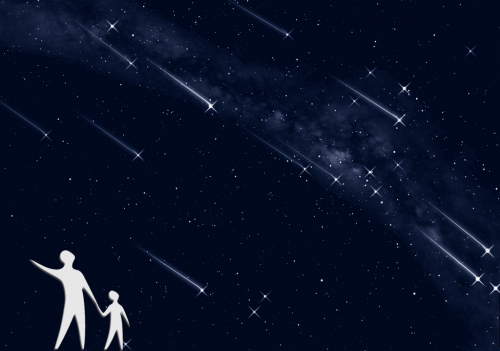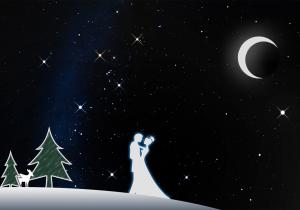
Geminid Meteor Shower 2019 - Under the Geminids - CLOSED
- Where:
- Frosty Drew Observatory
- When:
- Fri, Dec 13, 2019 - CLOSED
- Cost:
- $5 Suggested Donation per Person
Tonight is the peak night of the annual Geminid Meteor Shower, the most reliable and active meteor shower of the year. Sadly, tonight’s weather will be horrible! Forecasts are calling for heavy rain, starting this afternoon and lasting for most of the weekend, coupled with high winds and full cloud cover. This also marks 2019 as having all three of the best meteor showers of the year clouded out in Southern New England for the year. As such, we will be canceling our event tonight, and will remain closed. We’ll open next on Friday, December 20, 2019 at 7:00 pm for our Holiday Stargazing event. Let’s hope for a break in the deluge of late!
---------------------------------
Weekly Happenings
Scott MacNeill
Tonight, December 13, 2019, the annual Geminid Meteor Shower will peak. Usually producing an increase of up-to 150 meteors per hour in regular meteor activity, the Geminid shower is the best shower of the year. This year we have the bright 98% waning gibbous Moon accompanying the shower, which will obscure most of the meteors. So expectations will fall way below the ideal 150 meteors per hour. Though the Geminid shower is so active, and notable for producing bright fireball meteors, that the Moon will not render the shower a dud, and numerous Geminid meteors will still be visible. Sadly, Southern New England is awash in another deluge, so nice things are not allowed here, but if you find yourself under clear(er) skies tonight, it is certainly worth a trip out. Being that Moon is bright, you will not necessarily need to find a dark location to observe. Downtown urban settings may not be optimal, though light pollution, for the most part, will not outshine the bight Moon. The best times to be out are between 10:00 pm, and pre-dawn. Lay on your back so you are comfortably looking towards the zenith (top of the sky). If possible, set yourself up so the Moon is blocked from your view by a tree or building, this will allow you to see a few extra meteors. If you happen to catch a photo of a Geminid meteor, be sure to post it on our Facebook and we’ll share it on our timeline. Note, that we will not share photos of planes, even if you think it’s a meteor. Check out this image we captured last year of one hour from the 2018 Geminid Meteor Shower peak. Happy meteor watching!
This past Sunday, December 8, 2019, Comet 2I/Borisov made its closest approach to the Sun. What makes this comet so special is that, unlike all comets we observe, Borisov is not part of the Solar System, and is the second recorded interstellar object to pass through the Solar System. Think about that, comet 2I/Borisov is from another star! We don’t know what star the comet originated from, though we do know that it will not become part of the Solar System. The comet is traveling at near 100,000 miles per hour, and made its closest approach to the Sun at a distance of 2AU (1AU – Astronomical Unit, is the distance of Earth from the Sun). At that speed and distance, the Sun will not be able to capture the comet, meaning that it’s just passing through. Observations of the comet show that it is quite similar in composition to long period Oort Cloud comets (Solar System comets with an orbital period of over 200 years). The nucleus of the comet is only about 3,200 feet in diameter, though the comet’s coma (tenuous atmosphere that forms around the comet) is upwards of 14 times the size of Earth. Studying interstellar visitors to the Solar System help us to learn more about how we compare to other star systems. The more we learn, the more we realize how commonplace the Solar System is. Take a moment to catch up on the latest Hubble Space Telescope observation of comet 2I/Borisov.
Save the Date:
On New Years Eve, the Frosty Drew Observatory will open from 7:00 pm – 9:00 pm, offering a quick stargazing night to send off the decade. Our event will follow the Town of Charlestown’s annual New Year’s Eve bonfire in Ninigret Park (home to Frosty Drew), which starts around 4:30 pm. So add the stars to your list of year-end revelries and celebrate a fabulous decade, or shake off the dust of the disaster, with a night out under the stars before heading off to your final destination of the decade.
Happy second Friday the 13th of 2019 from all the astro-geeks at Frosty Drew Observatory!
-Scott
Take a minute to read up on visiting the Frosty Drew Observatory and catch up on what to / not to bring and how to adequately prepare for a comfortable nigh of meteor watching.
Please note that we do not allow any white lights on our campus from dusk - dawn. This is to ensure an equally awesome view of the night sky for all as well as to allow for the use of light sensitive astronomical equipment. Learn more about why we have this requirement in The Red Light District


_1576254428.jpg)
